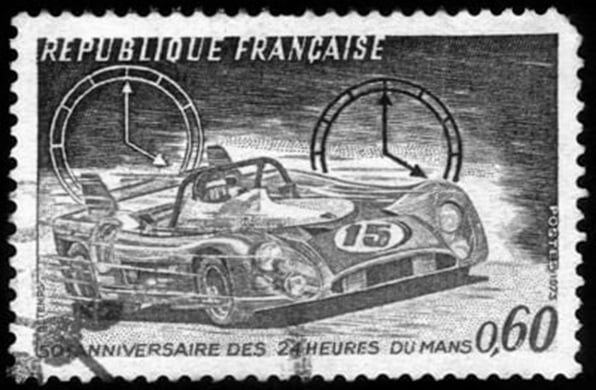I was recently asked if Ansible Motion built the very first motorsport-specific driving simulator. This was a compliment, I suppose – a bit of recognition that we’ve been designing and building Driver-in-the-Loop (DIL) simulators for racing applications for quite a long time. (We’ve been doing this for over 15 years now!)
But I had to answer “No.” Although high-level motorsport teams like Caterham F1 were indeed early adopters of our first DIL simulators, we were certainly not the first to bring DIL simulation into the mix of professional race car engineering programmes. We can only claim to have changed the game.
Ansible Motion, as a company, began in 2009 when we asked ourselves this question: What might an automotive driving simulator look like if we began with a clean sheet of paper? Our first Stratiform S1 motion system with its supporting ancillaries was the result. We departed from the popular-but-limited "hexapod" motion configuration, and invented a novel 6-DOF motion system built in logical layers corresponding directly to a vehicle’s primary axes. The goal was to be linear, agile and highly dynamic.
In fact, this founding, first-principles approach continues to guide our dynamic simulator developments today. If you take a casual look at the evolution of our Delta series simulators over the last decade and a half, from S1 to S3, the pedigree is evident. Some things change with the times. But we understand that the laws of physics do not.

Ansible Motion Delta DIL simulators, S1 (2009) – S3 (2024)
Motorsport Driving Simulator Origins
So, who did build the first racing simulator? Was it McLaren F1 perhaps? Or Ferrari? Or maybe Toyota?
McLaren F1 is certainly a solid guess, as the team is generally considered to be the first to prove the value of racing simulators as performance engineering tools to the automotive world at large, and might be identified as the singularity from which the “big bang” emerged in the mid-2000s – meaning the proliferation of driving simulators throughout Formula One, which then spread to other top series.
Of course, both Ferrari and Toyota might wish to claim this as well, having simultaneously – albeit more secretly – explored driving simulator technologies.

Toyota F1 racing simulator (2008)
Interestingly, the first racing simulator predates McLaren’s, Ferrari’s and Toyota’s Driver-in-the-Loop adventures by nearly a half-century.
Colin Chapman
Lotus founder, Colin Chapman, had, by 1966, already experienced the pinnacles of motor racing success, having won the Formula One world championship and the Indianapolis 500. Ever-eager to promote Lotus’s engineering capabilities, Chapman decided to take a swing at manufacturing driving simulators.
It may be that these Lotus driving simulators were purposed primarily toward brand promotion (as evidenced by the leading image above which shows Daily Express writer, David Benson, driving a Lotus 31 simulator at the London Racing Car Show in January, 1966.) But knowing Chapman’s engineering prowess, it is not hard to imagine that he envisioned – at least in part – using driving simulators as vehicle engineering and development tools.
All told, it’s reported that around 20 of these Lotus simulators were produced and sold in 1965 and 1966. They were clever exercises in engineering, as the following video demonstrates:
Lotus racing simulator overview ["in action" @ 2:30-onward]
The published, technical bulletin for the Lotus simulator described it as being based on “a patented aircraft simulator” - meaning Lotus likely licensed a part of the technology. In true DIL sense (and not unlike modern offerings such as Ansible Motion’s Sigma DIL simulators), the driver sat in a modified real car, fitted with driver instrumentation and control sensors (to measure steering, throttle, braking, gear selection, etc.) – all connected to a control computer, a vehicle dynamics model and a projection-based vision system.
Particularly interesting is the Lotus simulator’s vision system. Designed long before sophisticated real-time computer graphics came of age, the visuals were simulated by using a three-dimensional, physical, scale model of a race track set atop a 4-foot diameter rotating disc. A small camera, suspended over the track model on a cantilevered boom, provided a driver’s-view perspective of the modelled race track. The rotational speed of the track map disk was controlled by the driver’s throttle and brake inputs, and the lateral position of the camera relative to the track map was altered by a lower rotating disk (on which the camera boom was mounted) which was controlled by the driver’s steering inputs. Co-located with the camera on the boom was a bright light and mirror which reflected the reversed camera image onto the back of a translucent projection screen. In addition to the visual feedback, an audio buzzer was fitted to alert drivers of their off-track excursions.
Presto! All quite extraordinary for the time.

Lotus Driving Simulator – Technical Bulletin (1966)
Driving Simulator Perspective
Looking back offers not only a chance to admire the engineering achievements of the past, but to further appreciate the current state of the art in DIL simulation. It also provides some perspective on where DIL technology might be another decade or two from now.
I also can’t help but ponder the remarkable coincidence that Ansible Motion’s current headquarters in just down the road, a stone’s throw really, from Lotus’ headquarters. To think: This diminutive location on the world map - Hethel, England - has represented the epicentre of driving simulator development for all these years. I might also mention that I worked for Lotus, years ago, before joining Ansible Motion. Small world!
If you are interested in reading more about the current state of the art in racing simulators, we invite you to download our FREE eBook, Engineering the advantage: Driver-in-the-Loop simulation in motorsport:













